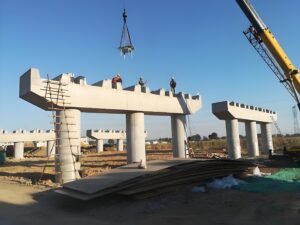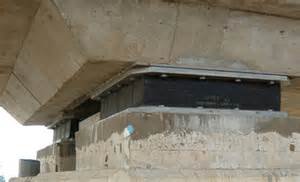Table of Contents
Bridging the Gap with Unwavering Support
Introduction
Bridge bearings are structural components that support and transfer loads from the bridge superstructure to the substructure. They allow for movement and rotation of the superstructure due to thermal expansion, contraction, and other factors, while maintaining structural integrity and stability. Bridge bearings play a crucial role in ensuring the safety and longevity of bridges.
Types of Bridge Bearings
Bridge bearings play a crucial role in the structural integrity and functionality of bridges. They serve as the interface between the bridge superstructure and the substructure, transmitting loads and accommodating movements while ensuring stability and durability.
There are various types of bridge bearings, each designed to meet specific requirements and conditions. One common type is the elastomeric bearing, which consists of layers of rubber or neoprene sandwiched between steel plates. Elastomeric bearings provide flexibility and damping, allowing for thermal expansion and contraction, as well as seismic movements.
Another type is the pot bearing, which comprises a cylindrical steel pot filled with a rubber or elastomeric material. Pot bearings offer high load-carrying capacity and can accommodate large rotations and displacements. They are often used in bridges with curved alignments or where significant movements are anticipated.
Rocker bearings, on the other hand, consist of a curved steel plate that rests on a flat surface. They allow for longitudinal movement while resisting vertical loads. Rocker bearings are suitable for bridges with straight alignments and minimal thermal expansion.
Sliding bearings, as the name suggests, allow for movement in one or more directions. They typically consist of a flat steel plate sliding on a lubricated surface. Sliding bearings are commonly used in bridges where large thermal movements or seismic forces are expected.
In addition to these conventional types, there are also specialized bearings designed for specific applications. For example, seismic isolation bearings are designed to reduce the transmission of seismic forces to the bridge superstructure, protecting it from damage during earthquakes.
The selection of the appropriate bridge bearing type depends on factors such as the bridge design, load requirements, environmental conditions, and anticipated movements. Engineers carefully consider these factors to ensure that the bearings provide optimal performance and contribute to the overall safety and longevity of the bridge.
Bridge bearings are essential components that enable bridges to withstand various loads and movements while maintaining structural integrity. By understanding the different types of bearings and their applications, engineers can design and construct bridges that are both safe and efficient.
Design Considerations for Bridge Bearings
Bridge bearings play a crucial role in the structural integrity and performance of bridges. They serve as the interface between the bridge superstructure and the substructure, transmitting loads and accommodating movements while ensuring stability and durability.
The design of bridge bearings involves careful consideration of various factors, including the type of bridge, the magnitude and direction of loads, and the environmental conditions. The choice of bearing type depends on the specific requirements of the bridge, such as its span length, load capacity, and movement capabilities.
Common types of bridge bearings include elastomeric bearings, steel bearings, and pot bearings. Elastomeric bearings are made of rubber or a rubber-like material and provide flexibility and vibration damping. Steel bearings are typically used for heavy loads and offer high strength and durability. Pot bearings consist of a steel cylinder filled with a viscous fluid and provide rotational and translational movement.
The design of bridge bearings must also account for the effects of temperature, creep, and fatigue. Temperature variations can cause thermal expansion and contraction, which can lead to bearing movement and stress. Creep is the gradual deformation of a material under sustained load, which can affect the bearing’s performance over time. Fatigue is the weakening of a material due to repeated loading, which can compromise the bearing’s integrity.
To ensure the reliability and longevity of bridge bearings, proper maintenance and inspection are essential. Regular inspections can identify any signs of wear, damage, or corrosion, allowing for timely repairs or replacements. Maintenance activities may include cleaning, lubrication, and adjustment of the bearings to maintain their optimal performance.
In addition to the technical considerations, the design of bridge bearings must also consider aesthetic and environmental factors. The appearance of the bearings can impact the overall aesthetics of the bridge, and the materials used should be environmentally friendly and sustainable.
By carefully considering the design, selection, and maintenance of bridge bearings, engineers can ensure the safety, functionality, and longevity of bridges. These critical components play a vital role in the performance of bridges, enabling them to withstand the demands of traffic, environmental conditions, and time.
Installation and Maintenance of Bridge Bearings
Bridge bearings play a crucial role in the structural integrity and longevity of bridges. They provide support and allow for movement between the bridge deck and the substructure, accommodating thermal expansion, contraction, and other forces. Proper installation and maintenance of bridge bearings are essential to ensure the safety and performance of these critical structures.
During installation, it is imperative to follow the manufacturer’s specifications and industry best practices. The bearing surfaces must be clean and level, and the bearings must be properly aligned and secured. The use of appropriate tools and equipment is crucial to prevent damage or misalignment.
Regular inspection and maintenance are vital to ensure the continued functionality of bridge bearings. Visual inspections should be conducted periodically to identify any signs of wear, corrosion, or damage. More detailed inspections may be necessary if any anomalies are observed.
Maintenance activities may include cleaning, lubrication, and replacement of damaged components. Cleaning removes dirt and debris that can accumulate over time, while lubrication reduces friction and wear. In cases where bearings have become severely damaged or worn, replacement may be necessary to restore their functionality.
The frequency of inspection and maintenance depends on several factors, including the type of bearing, traffic volume, and environmental conditions. High-traffic bridges or those located in harsh environments may require more frequent attention.
Proper installation and maintenance of bridge bearings not only extend their lifespan but also contribute to the overall safety and reliability of bridges. By adhering to industry standards and best practices, engineers and maintenance crews can ensure that these critical components continue to perform their intended function for years to come.
Neglecting bridge bearing maintenance can have severe consequences. Worn or damaged bearings can lead to excessive movement, cracking, and even collapse of the bridge deck. Regular inspections and timely maintenance are essential to prevent such catastrophic failures and ensure the safety of the traveling public.
In conclusion, bridge bearings are essential components that play a vital role in the structural integrity and performance of bridges. Proper installation and maintenance are crucial to ensure their longevity and the safety of these critical structures. By following industry best practices and conducting regular inspections and maintenance, engineers and maintenance crews can contribute to the long-term reliability and safety of our bridges.
Failure Modes and Prevention in Bridge Bearings
Bridge bearings play a crucial role in the structural integrity and longevity of bridges. They facilitate movement between the bridge deck and its supports, accommodating thermal expansion, contraction, and other loads. However, bearing failures can compromise bridge safety and serviceability, leading to costly repairs or even catastrophic consequences.
One common failure mode is excessive wear or corrosion. Bearings subjected to heavy traffic or harsh environmental conditions can experience wear on their sliding surfaces, leading to reduced load capacity and increased friction. Corrosion, caused by moisture and chemical exposure, can weaken bearing components and accelerate wear.
Another failure mode is fatigue. Repeated loading and unloading cycles can cause cracks to develop in bearing components, eventually leading to failure. Fatigue is particularly prevalent in bearings with high stress concentrations or inadequate design.
Improper installation or maintenance can also contribute to bearing failures. Incorrect alignment or insufficient lubrication can lead to premature wear and damage. Regular inspections and maintenance are essential to detect and address potential problems before they escalate into major failures.
To prevent bearing failures, engineers employ various design and maintenance strategies. Selecting the appropriate bearing type for the specific bridge conditions is crucial. Elastomeric bearings, for example, offer flexibility and durability, while steel bearings provide high load capacity.
Proper design considerations include accounting for thermal expansion and contraction, as well as the anticipated loads and environmental conditions. Corrosion-resistant materials and coatings can extend bearing life in harsh environments.
Regular inspections and maintenance are essential for early detection of bearing issues. Visual inspections can identify signs of wear, corrosion, or misalignment. Non-destructive testing techniques, such as ultrasonic testing, can assess the internal condition of bearings without disassembly.
By implementing these preventive measures, engineers can minimize the risk of bearing failures and ensure the safety and reliability of bridges for years to come. Regular monitoring, timely maintenance, and appropriate design choices are key to extending bearing life and safeguarding the integrity of these critical infrastructure components.
Innovations in Bridge Bearing Technology
**Bridge Bearing: Innovations in Bridge Bearing Technology**
Bridge bearings play a crucial role in the structural integrity and longevity of bridges. They provide support and allow for movement between the bridge deck and the substructure, accommodating thermal expansion, contraction, and other loads. Over the years, advancements in bridge bearing technology have significantly improved the performance and durability of these critical components.
One notable innovation is the introduction of elastomeric bearings. These bearings consist of layers of rubber or neoprene sandwiched between steel plates. They offer excellent flexibility, allowing for large rotations and displacements while providing high load-carrying capacity. Elastomeric bearings are commonly used in bridges with curved decks or those subjected to seismic forces.
Another advancement is the development of pot bearings. These bearings consist of a steel pot filled with a viscous fluid, such as oil or grease. The fluid provides damping, reducing vibrations and improving the overall stability of the bridge. Pot bearings are particularly suitable for bridges with heavy traffic or those located in areas with high seismic activity.
Fiber-reinforced polymer (FRP) bearings are another innovative type of bearing. FRP bearings are made from composite materials that combine the strength of fibers with the flexibility of polymers. They offer high strength-to-weight ratios, corrosion resistance, and excellent fatigue resistance. FRP bearings are increasingly used in bridges where weight reduction and durability are critical factors.
In addition to these material innovations, advancements have also been made in the design and analysis of bridge bearings. Finite element analysis (FEA) is now widely used to simulate the behavior of bearings under various loading conditions. This allows engineers to optimize the design and predict the performance of bearings more accurately.
Furthermore, the use of sensors and monitoring systems has become increasingly common in bridge bearings. These systems provide real-time data on the condition of the bearings, allowing for early detection of any potential issues. This proactive approach to maintenance helps extend the lifespan of bridges and ensures their safety and reliability.
As bridge bearing technology continues to evolve, we can expect further advancements that will enhance the performance, durability, and safety of bridges. These innovations will contribute to the construction of more resilient and sustainable bridges that can withstand the demands of modern transportation systems.
Q&A
**Question 1:** What is a bridge bearing?
**Answer:** A bridge bearing is a structural component that supports the bridge deck and transfers loads from the deck to the substructure.
**Question 2:** What are the different types of bridge bearings?
**Answer:** Common types of bridge bearings include elastomeric bearings, steel bearings, and pot bearings.
**Question 3:** What is the function of a bridge bearing?
**Answer:** Bridge bearings allow for movement of the bridge deck due to thermal expansion, contraction, and other factors, while maintaining structural integrity.
**Question 4:** What are the factors to consider when selecting a bridge bearing?
**Answer:** Factors to consider include load capacity, movement requirements, durability, and cost.
**Question 5:** How are bridge bearings installed?
**Answer:** Bridge bearings are typically installed by placing them on the substructure and then lowering the bridge deck onto them.
Conclusion
**Conclusion**
Bridge bearings play a crucial role in the structural integrity and performance of bridges. They provide support, transfer loads, and accommodate movements due to thermal expansion, contraction, and seismic activity. By selecting and designing appropriate bearings, engineers can ensure the safety, durability, and functionality of bridges under various loading conditions and environmental factors.



